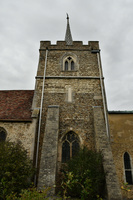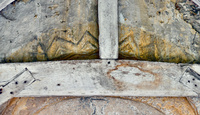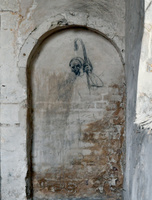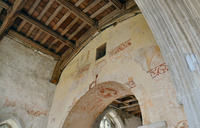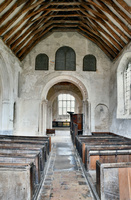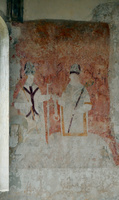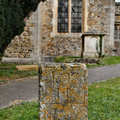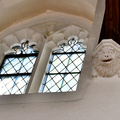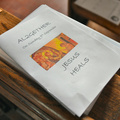Duxford is famous for its airfield which dates back to the First World War when many of the buildings still seen on the site were built by German prisoners of war. It remained a Royal Air Force facility after the war with several different aircraft including Sopwith Snipes, Gloster Grebes, Armstrong Whitworth Siskins, Bristol Bulldogs, Gloster Bulldogs and, from 1938, Supermarine Spitfires all being based there. It was also home to the Cambridge University Air Squadron, of which one member was Frank Whittle who is often credited with inventing the turbojet engine. Early in the Second World War it became home to 310 Squadron, which was made up of Czechoslovakian pilots and flew Hawker Hurricanes; they were joined by 242 Squadron which also flew Hurricanes and was led by the legendary air ace Douglas Bader who had lost both legs in a crash in 1931 and, following his capture in 1941, spent the remainder of the war in Colditz. 302 Squadron, made up of Polish pilots flying Spitfires (a photo of one of their pilots flying a Spitfire was later accidentally used to widespread hilarity by the far-right British National Party on the cover of a leaflet opposing the immigration of East Europeans into the UK), were also based at Duxford. From 1943, the airfield was handed over to to the USAAF and, over the course of the rest of the conflict, hosted nine units flying Thunderbolts, Airacobras, Liberators and Flying Fortresses. Several of the aircraft that were based there during and between both wars and afterwards can now be seen in the Imperial War Museum that now occupies the site.
Not so famous is Duxford village which, having a large population since early times, was split into two parishes with two churches - St Johns and St Peters, both dating from the 12th Century. Part of St Johns was used as a school for two centuries up until 1847, suggesting it had already become too large for the requirements of its parish, and in 1874 when the two parishes were merged into one the church was abandoned and left to become derelict. It stood empty and unused for more than a century, slowly turning into a ruin, until 1979 when it was placed into the care of the Churches Conservation Trust.
Whilst the church was so nearly lost, that period of disuse has left it very interesting indeed from a historical point of view - during the late Victorian period, when there was a craze for medieval revivalism, many genuinely medieval churches were renovated in a style people thought they ought to have rather than being true to the authentic style - hence so many churches have austere white walls, covering the richly-coloured (and often rather gruesome) wallpaintings that once adorned them. St Johns escaped that; among its many paintings are two priests, St Margaret (much beloved by poor farm workers as the patron saint of peasants) being tortured, various Christs and lots of decorative motifs. There is also a great deal of graffiti dating back centuries scratched into the stonework, as well as many odd straight lines which confuse those who don't know what they are - they were made by medieval parishioners who used the rough stonework to sharpen their arrows during services!
Nowadays, the church is still rarely used for religious purposes but does host an occasional service; instead, it's used for a range of village functions and hosts a market every Christmas.
Photos
1: the tower, built in the 12th Century. It has no bells as they were moved to St Peters in 1949. The top of the spire is twisted as someone climbed up it to attach a flag to celebrate the diamond jubilee of Queen Victoria in 1897 and a strong wind bent it.
2: The original Norman doorway, with typically Norman chevron carving.
3: A drawing in pencil of Christ, which looks like Death when you first walk in. It's believed to have been added by an RAF spotter during WW2 when the tower was used to watch for incoming enemy aircraft; it must have been a spooky place to spend the night.
4: Interior arch leading to the altar, with medieval decorative motifs and patterns.
5: Looking down the ailse towards the altar. On the floor are slabs marking medieval tombs.
6: The exterior. The graveyard, with the stones removed and lined up against the wall, has been allowed to return to nature.
7: Stairway leading up into the tower. It's not much more than a foot wide and I don't like tight, enclosed spaces so I didn't go up there!
8: Another shot towards the altar.
9: An old Bible on the pulpit.
10: The two priests wall painting.


Enjoy being online again!
Welcome to the community of good people who base their values on evidence and appreciate civil discourse - the social network you will enjoy.Create your free account
2 comments
Feel free to reply to any comment by clicking the "Reply" button.Wow, absolutely amazing. I love old buildings and am very happy that this didn't get knocked down our modified to more modern expectations. It has an amazing history. Thank you ever so much for sharing. I throughly enjoyed it.
Jnei:
A 17th Century gravestone
Jnei:
The interior, looking towards the altar.
Jnei:
Interior decoration.
Jnei:
An eroded gargoyle.
Jnei:
I don't think anyone's been through this door in a long time!
Jnei:
With the airfield just up the road and so many others nearby, there are a lot of these in the local churchyards marking the graves of thousands of people from all the Allied nations.
Jnei:
I decided not to take a copy home to read
Enjoy being online again!
Welcome to the community of good people who base their values on evidence and appreciate civil discourse - the social network you will enjoy.Create your free account
Share this post
Categories
Agnostic does not evaluate or guarantee the accuracy of any content. Read full disclaimer.
